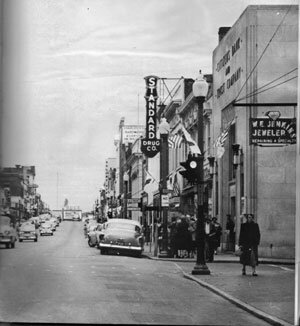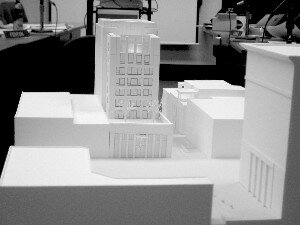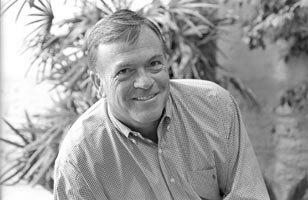ONARCHITECTURE- Bright idea: Danielson's Beacon's back in town
"I think the Terraces is a good building, not a great building," developer Oliver Kuttner told his architects, standing last year in the former Central Fidelity Bank building on the Downtown Mall. "But I have a second chance, so let's build a great building."
A dusty space left empty since early 2003 when software company Boxer Learning suddenly downisized, the big black granite building was being gutted and readied for an ambitious Kuttnerian overhaul. The man who built two of downtown's most notable structures (in addition to the Terraces in the old Woolworth's space, he also did the Glass Building on Second street SE) and operates a popular shuttle bus to New York City, said he wanted an "apocalyptic look" for his latest Downtown Mall confection. As it turns out, however, it's not Kuttner getting a second chance, but the über-Downtown Mall overhauler from the 1990s, Lee Danielson, the man who developed the Regal Cinema and the Charlottesville Ice Park.
Danielson sold Kuttner the Boxer building last year for $3.7 million after financing for a BAR-approved nine-story hotel fell through. Now, in what might appear to be a game of hot potato between the two developers, Kuttner has agreed to sell the building back to Danielson for an undisclosed sum following the BAR's late February re-approval of the hotel.
Clues about Kuttner's willingness to bail were evident back in August.
"This is the deal that could sink me," he told the Hook, revealing that interest on borrowed money and other expenses amounted to a $1,000 per day "carrying cost."
Early drawings showed a dynamic three-story mixed-use complex with apartments, store space, and offices embedded in a dramatic facade along Second Street, which he planned to fabricate of stainless steel in China while labor was still cheap. Kuttner had also shown interest in turning the bank's steel vault into retail space.
"I love that building," says Kuttner, who admits that while he obtained money to renovate the front of the building, he had not yet secured funds for the back. Never fond of rules and regulations, Kuttner appears to have grown weary of the "variables" involved in seeing a building through to completion.
"Building a building in Charlottesville is not fun anymore," says Kuttner, who has– when he's not building race cars– started a number of warehouse renovations in Lynchburg.
"In Lynchburg it's still fun," says Kuttner. "In Lynchburg, I find myself free to push the envelope, to still be creative." As for Danielson, "I thought Lee had done a lot of good groundwork. It's a notch above anything else being built in Charlottesville."
Kuttner's concession to Danielson may mean the construction of a nine-story building that could finally serve as a model for future Mall projects. Indeed, on February 20, the hotel moved easily past a BAR that has been squeamish about tall building projects, especially on and around the Mall.
"They really did hit a home run with the design," says BAR vice-chair Syd Knight. "They were extremely sensitive to the three-story feel on the Mall."
Knight, lately such a critic of nine-story building projects (specifically, the recently approved condo building at 201 Avon Street, which he voted against), says he was impressed by the way Danielson's architects had worked the existing facade into the design, set the bulk of the upper stories farther back than even the BAR had recommended (the shadow the building will cast will fall upon the building itself), and positioned the hotel's entrance on Water Street under a porte-cochere.
"They worked very hard to create a building that's quite modern, but respects the historic character of the Mall," says Knight. "So many buildings in town tend to be caricatures of Jeffersonian architecture, but this one does a good job of walking the line between the present and the past. They really did their homework."
Indeed, architects learned that the old Boxer/Central Fidelity building was originally two buildings before the bank renovation in 1965, and that the eastern half of the building was the original home of Woolworth's, which opened in the early 1920s and operated there for nearly 40 years. They also learned that the building may have been the only bank in the United States to be opened at the height of the Great Depression in 1931. Although no photos of the original bank survive, an article in the Daily Progress at the time hailed it as a futuristic wonder with a design of "magnificent simplicity." (One of Kuttner's first moves was finding a home in the Frank Ix building for a 50-foot long, 10-foot high banking lobby mural of the Blue Ridge Mountains painted in 1955 by H. Warren Billings.)
The website of San Francisco-based architect Mark Hornberger, who happens to be an old high school buddy of Danielson, suggests a lover of history. His firm, Hornberger-Worstell, has designed academic buildings and residences all around the world as wells as spas, hotels, and resorts, including California's historic Hotel del Coronado. Particularly striking is the 27-story W hotel in San Francisco's arts and convention district, which has a fitness center and a glass-covered swimming pool, but also features intimate and dynamic lobby and bathroom designs worthy of private homes.
What's striking also is the way various projects respect the architectural styles of their environments. For instance, the Sonoma Mission Inn and Spa in California adopts a decidedly Spanish style, while the Hyatt Beaver Creek Resort in Colorado looks like an Alpine chalet.
Although it was presented as "Hotel Charlottesville" three years ago and as "The Landmark Hotel" at late February's BAR meeting, Danielson has since changed the project's name to "The Beacon-Charlottesville." After all, the structure's defining architectural attribute is a light behind glass panels at the top of the planned 101-foot structure.
A high-end "boutique" hotel about twice the size of the Live Arts Building and about the same height as the nearby Wachovia tower, the Beacon-Charlottesville will feature an upscale bistro in the former banking lobby. Danielson– who used to tangle with the BAR over everything from erecting a kiosk to removing Mall "spider lights"– is choosing his words more carefully this time around. He'll speak only through a PR firm.
"I feel deeply that Charlottesville needs a project of this caliber," a spokesperson at Payne, Ross & Associates says he says. "I never gave up on that belief, and I'm delighted that events have unfolded as they have."
According to Danielson, construction will begin this summer, and Charlottesville's nine-story "Beacon" should be ready to shine in the Fall of 2008.

The Downtown Mall before it was pedestrian, and the Central Fidelity Bank building before it took over the nearby Woolworth's building and added the black granite facade in 1965. Now it's poised to become the ritzy "Beacon."
PHOTO COURTESY ALBEMARLE CHARLOTTESVILLE HISTORIC SOCIETY

Lee Danielson's proposed hotel, center, would cast a shimmering light toward the equally tall Wachovia tower.
FILE PHOTO BY HAWES SPENCER

Lee Danielson
FILE PHOTO BY JEN FARIELLO
#